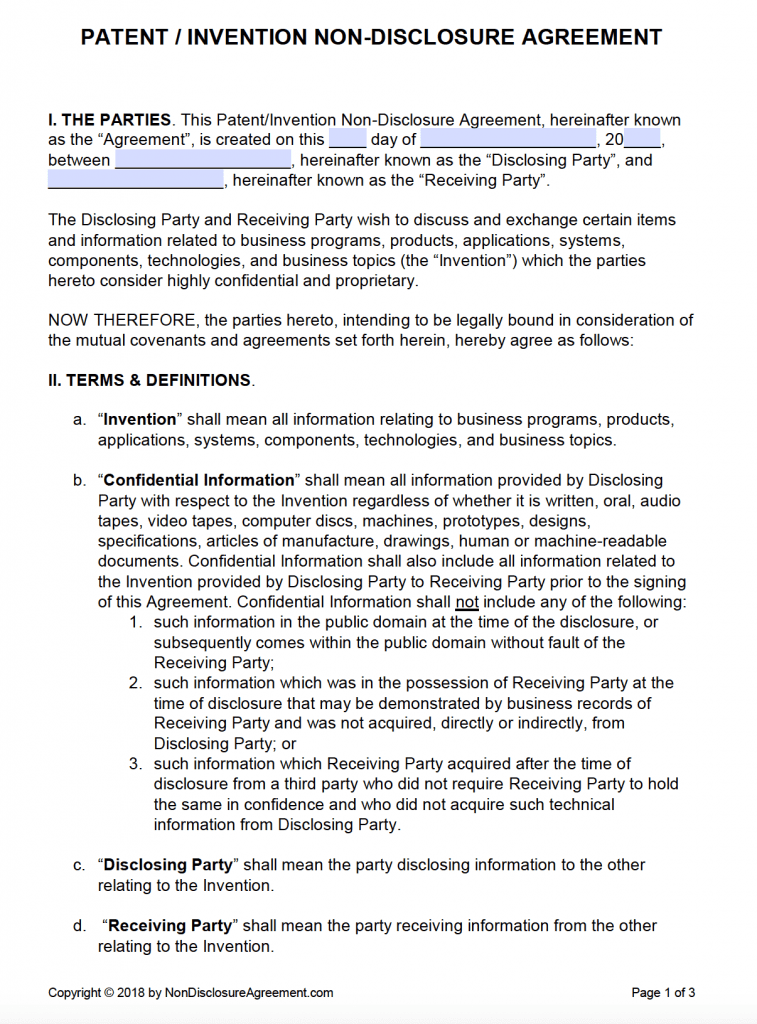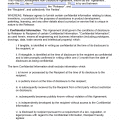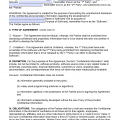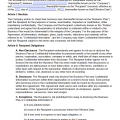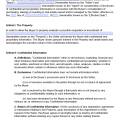Patent (Invention) Non-Disclosure Agreement (NDA)

The patent non-disclosure agreement is not intended to prevent the disclosure of a U.S. patent; rather it is intended to prevent the disclosure of confidential information in a pending patent application, confidential know-how connected with a patent or application, or innovations or strategies that may become the basis of a patent application. You should use this agreement with a manufacturer, investor, contractor, prototype-maker, or invention agent. You cannot use this nondisclosure agreement to protect the contents of a patent granted by the U.S. Patent and Trademark Office (USPTO). That’s because as part of the grant process, the patent is published and incorporated into the USPTO’s public database. Many patent applications are published 18 months after filing. All applications are published prior to issuance.
Sample
Patent (Invention) Non-Disclosure Agreement
This Patent (Invention) Non-Disclosure Agreement (the “Agreement”) is entered into by and between _______________ (“Disclosing Party”) and __________________ (“Receiving Party”). The parties agree to enter into a confidential relationship with respect to preventing the unauthorized disclosure of certain proprietary and confidential information (the “Confidential Information”), as defined below.
1. Definition of Confidential Information (Written or Oral)
For purposes of this Agreement, “Confidential Information” shall include all information or material that has or could have commercial value or other utility in the business in which Disclosing Party is engaged including, but not limited to information or data relating to an innovation or intellectual property developed or owned by Disclosing Party, as well as information in a pending patent application, confidential know-how connected with a patent or application, or innovations or strategies that may became the basis of a patent application. In the event that Confidential Information is in written form, the Disclosing Party shall label or stamp the materials with the word “Confidential” or some similar warning. In the event that Confidential Material is transmitted orally, the Disclosing Party shall promptly provide a writing indicating that such oral communication constituted Confidential Information.
2. Exclusions From Confidential Information
Receiving Party’s obligations under this Agreement shall not extend to information that is (a) publicly known at the time of disclosure under this Agreement or subsequently becomes publicly known through no fault of the Receiving Party; (b) discovered or created by the Receiving Party prior to the time of disclosure by Disclosing Party; or (c) otherwise learned by the Receiving Party through legitimate means other than from the Disclosing Party or anyone connected with the Disclosing Party.
3. Obligations of Receiving Party
The Receiving Party shall hold and maintain the Confidential Information of the other party in strictest confidence for the sole and exclusive benefit of the Disclosing Party. The Receiving Party shall carefully restrict access to any such Confidential Information to persons bound by this Agreement, only on a need-to-know basis. The Receiving Party shall not, without prior written approval of the Disclosing Party, use for the Receiving Party’s own benefit, publish, copy, or otherwise disclose to others, or permit the use by others for their benefit or to the detriment of the Disclosing Party, any of the Confidential Information. The Receiving Party shall return to Disclosing Party any and all records, notes, and other written, printed, or tangible materials in its possession pertaining to the Confidential Information immediately on the written request of Disclosing Party.
4. Term
This Agreement and Receiving Party’s duty to hold Confidential Information in confidence shall remain in effect until _________________ or until whichever of the following occurs first: (a) Disclosing Party sends Receiving Party written notice releasing it from this Agreement, or (b) Confidential Information disclosed under this Agreement ceases to be confidential.
5. No Intellectual Property Rights Granted
This Agreement does not constitute a grant or an intention or commitment to grant any right, title or interest in the Disclosing Party’s innovations, intellectual property, or the Confidential Information, to Receiving Party.
6. General Provisions
(a) Relationships. Nothing contained in this Agreement shall be deemed to constitute either party a partner, joint venturer or employee of the other party for any purpose.
(b) Severability. If a court finds any provision of this Agreement invalid or unenforceable, the remainder of this Agreement shall be interpreted so as best to effect the intent of the parties.
(c) Integration. This Agreement expresses the complete understanding of the parties with respect to the subject matter and supersedes all prior proposals, agreements, representations and understandings. This Agreement may not be amended except in a writing signed by both parties.
(d) Waiver. The failure to exercise any right provided in this Agreement shall not be a waiver of prior or subsequent rights.
(e) Injunctive Relief. Any misappropriation of Confidential Information in violation of this Agreement may cause Disclosing Party irreparable harm, the amount of which may be difficult to ascertain, and therefore Receiving Party agrees that Disclosing Party shall have the right to apply to a court of competent jurisdiction for an order enjoining any such further misappropriation and for such other relief as Disclosing Party deems appropriate. This right of Disclosing Party is to be in addition to the remedies otherwise available to Disclosing Party.
(f) Attorney Fees and Expenses. In a dispute arising out of or related to this Agreement, the prevailing party shall have the right to collect from the other party its reasonable attorney fees and costs and necessary expenditures.
(g) Governing Law. This Agreement shall be governed in accordance with the laws of the State of _________________.
(h) Jurisdiction. The parties consent to the exclusive jurisdiction and venue of the federal and state courts located in _________________ in any action arising out of or relating to this Agreement. The parties waive any other venue to which either party might be entitled by domicile or otherwise.
(i) Successors & Assigns. This Agreement shall bind each party’s heirs, successors and assigns. Receiving Party may not assign or transfer its rights or obligations under this Agreement without the prior written consent of Disclosing Party. However, no consent is required for an assignment or transfer that occurs: (a) to an entity in which Receiving Party owns more than fifty percent of the assets; or (b) as part of a transfer of all or substantially all of the assets of Receiving Party to any party. Any assignment or transfer in violation of this section shall be void.
Disclosing Party:
_____________________________________________ (Signature)
_____________________ (Typed or Printed Name)
Title: _____________________
Date: _____________________
Receiving Party:
_____________________________________________ (Signature)
_____________________ (Typed or Printed Name)
Title: _____________________
Date: _____________________
How to Write
EXPLANATION FOR PATENT (INVENTION) NON-DISCLOSURE AGREEMENT
Below we provide an explanation for each of the provisions in the Patent (Invention) Non-Disclosure Agreement.
Introductory Paragraph
Fill in your name or company name (you, the inventor or invention rights owner, are the disclosing party). Fill in the name of the receiving party, that is, the individual or company considering a commercial transaction (for example, a potential manufacturer or invention agent).
1. Definition of Confidential Information (Written or Oral)
This section defines what is protected against disclosure. Keep in mind that if you are providing documentation, you should designate that information as confidential. If the information is spoken, you “shall promptly provide a writing indicating that such oral communication constituted Confidential Information.”
2. Exclusions from Confidential Information
This provision describes all the types of information that are not covered by the agreement. These exclusions are based on court decisions and state trade secret laws that say these types of information do not qualify for trade secret protection.
3. Obligations of Receiving Party
This clause makes clear that your trade secrets must be kept in confidence by the receiving party and may not be revealed to others without your prior written consent.
The receiving party also promises to return materials that you provided.
4. Term
This clause provides the receiving party with an expiration date for the agreement. The Agreement should last as long as the information is likely to remain a trade secret. Five years is a common period, but it can be much shorter, even as little as six months.
5. No Intellectual Property Rights Granted
This clause makes clear that you are not granting any ownership rights in your intellectual property or the confidential information to the receiving party.
6. General Provisions
These miscellaneous provisions (sometimes referred to as “boilerplate”) are usually grouped together at the end of an agreement.
(a) Relationships. Most agreements include a provision like this one, disclaiming any relationship other than that defined in the agreement.
(b) Severability. The severability clause provides that if you wind up in a lawsuit over the agreement and a court rules that one part of the agreement is invalid, that part can be cut out and the rest of the agreement will remain valid.
(c) Integration. The integration provision verifies that the version you are signing is the final version, and that neither of you can rely on statements made in the past.
(d) Waiver. This provision states that even if you don’t promptly complain about a violation of the NDA, you still have the right to complain about it later.
(e) Injunctive Relief. An injunction is a court order directing a person to do (or stop doing) something. If someone violated your NDA, you would want a court order directing that person to stop using your secrets.
(f) Attorney Fees and Expenses. If you don’t include an attorney fees clause in your agreement, a judge may (in most states) order the award of attorney fees in cases where the theft of the trade secret was willful and malicious. It’s up to the judge, which makes things unpredictable. You are far better off using an attorney fees provision. However, don’t be surprised if the other party is opposed to the idea. Why? Because it is the receiving party that is usually sued, not vice-versa, and the receiving party may believe that the provision will encourage you to litigate.
(g) Governing Law. You can choose any state’s laws to govern the agreement, though the most logical state for this provision is the state where the property is located.
(h) Jurisdiction. The purpose of adding a jurisdiction provision to an NDA is to get each party to consent in advance to jurisdiction in one county or state and to give up the right to sue or be sued anywhere else. As with the previous provision, the most likely choice is the county in which the property is located.
(i) Successors and Assigns. This provision binds any company that acquires either party.
Signing the agreement. Someone with the necessary authority must sign the agreement on behalf of each party. Each party should sign two copies and keep one. This way, both parties have an original signed agreement.
